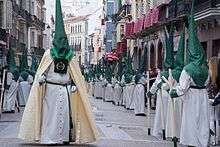Capirote
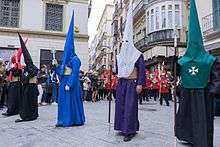
A capirote[1] is a pointed hat of conical form that is used in Spain. It is part of the uniform of some brotherhoods including the Nazarenos and Fariseos during Easter observances and reenactments in some areas during Holy Week in Spain.
History
Historically, the flagellants are the origin of the current traditions, as they flogged themselves to do penance. Pope Clement VI ordered that flagellants could perform penance only under control of the church; he decreed Inter sollicitudines ("inner concerns" for suppression).[2] This is considered one of the reasons why flagellants often hid their faces.
The use of the capirote or coroza was prescribed in Spain and Portugal by the holy office of Inquisition. Men and women who were arrested had to wear a paper capirote in public as sign of public humiliation. The capirote was worn during the session of an Auto-da-fé. The colour was different, conforming to the judgement of the office. People who were condemned to be executed wore a red coroza. Other punishments used different colours.
When the Inquisition was abolished, the symbol of punishment and penitence was kept in the Catholic brotherhood. However, the capirote used today is different: it is covered in fine fabric, as prescribed by the brotherhood. Later, during the celebration of the Holy Week/Easter in Andalusia, penitentes (people doing public penance for their sins) would walk through streets with the capirote.
The capirote is today the symbol of the Catholic penitent: only members of a confraternity of penance are allowed to wear them during solemn processions. Children can receive the capirote after their first holy communion, when they enter the brotherhood.
Fabric
Historically the design is called the capirote, but the brotherhoods cover it with fabric together with their face, and the medal of the brotherhood that is worn underneath. The cloth has two holes for the penitent to see through. The insignia or crest of the brotherhood is usually embroidered on the capirote in fine gold.
The capirote is worn during the whole penance. In Seville, one is not allowed to enter a cathedral without the capirote.[3]
Other uses
In New Orleans during the period between the Rebellion of 1768 and the abolishment of the Spanish cabildo, the more risqué Mardi Gras celebrations of the traditionally French Catholic residents were strictly curtailed by incoming Spanish clergy. The anti-Catholic second Ku Klux Klan that arose at the beginning of the twentieth century may have modeled part of their regalia and insignia on the capirote and sanbenito as a sardonic nod to the enforcement of these restrictions on masquerades a century earlier.
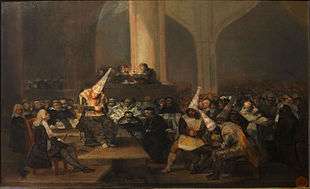
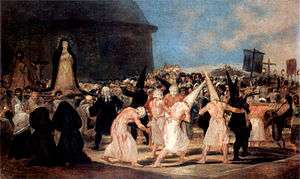 A Procession of Flagellants, Goya, 1812-1819
A Procession of Flagellants, Goya, 1812-1819 Prisoner wearing capirote and Sanbenito, Goya
Prisoner wearing capirote and Sanbenito, Goya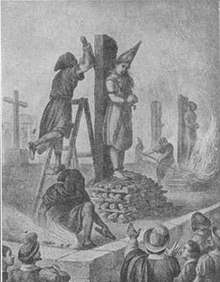 Execution of Francisca Nuñez de Carabajal, Mexico City, 1601
Execution of Francisca Nuñez de Carabajal, Mexico City, 1601
